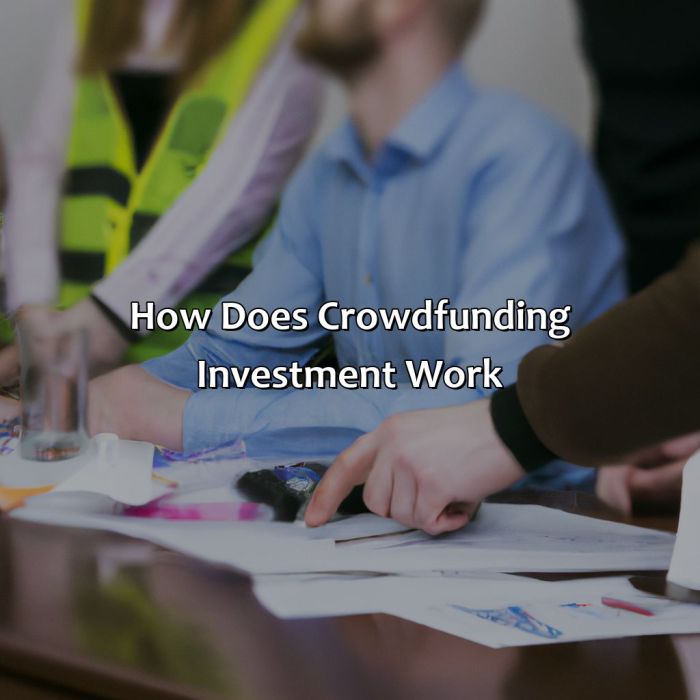Crowdfunding as an investment option opens up a world of possibilities for savvy investors looking to diversify their portfolios and support innovative projects. From understanding the basics to exploring the various types and risks involved, this guide delves into the realm of crowdfunding as a viable investment avenue.
As we navigate through the nuances of crowdfunding for investments, we uncover the key factors that shape this dynamic landscape, paving the way for informed decision-making and strategic investment opportunities.
Introduction to Crowdfunding as an Investment Option
Crowdfunding is a method of raising capital by collecting small amounts of money from a large number of people, typically via online platforms. In the context of investments, crowdfunding provides individuals with the opportunity to invest in a wide range of projects or businesses, often with relatively low entry barriers compared to traditional investment options.
Using Crowdfunding Platforms for Investment Purposes
Crowdfunding platforms serve as intermediaries that connect investors with entrepreneurs or project owners seeking funding. These platforms allow investors to browse through various investment opportunities, ranging from startups and real estate projects to artistic endeavors and social causes. By investing through crowdfunding platforms, individuals can diversify their investment portfolio and support innovative ideas that align with their interests.
Benefits of Crowdfunding as an Investment Option
- Accessibility: Crowdfunding provides a platform for individuals to invest in projects that may not have been accessible through traditional investment channels.
- Diversification: Investors can spread their capital across multiple projects, reducing risk and potentially increasing returns.
- Support for Innovation: Crowdfunding allows investors to support innovative and entrepreneurial initiatives that have the potential to drive positive change.
- Potential for High Returns: Some crowdfunding investments have the potential to generate high returns, especially in the case of successful startups or projects with significant growth prospects.
- Community Engagement: Investing through crowdfunding platforms fosters a sense of community and collaboration among investors, project creators, and supporters.
Types of Crowdfunding for Investment

Crowdfunding for investment comes in various forms, each with its own set of risks and potential returns. It is essential to understand the different types available to make informed investment decisions.
Equity Crowdfunding
Equity crowdfunding allows investors to purchase shares or ownership stakes in a company. In return, investors receive a share of the company’s profits. This type of crowdfunding offers the potential for high returns but also comes with higher risks as the success of the investment is tied to the success of the company.
Debt Crowdfunding
Debt crowdfunding involves investors lending money to a company or individual in exchange for repayment with interest over a set period. This type of crowdfunding offers more stability compared to equity crowdfunding, but the returns are typically lower.
Reward-Based Crowdfunding
Reward-based crowdfunding involves investors contributing funds to a project or business in exchange for a non-financial reward, such as a product or service. While the financial returns may be limited, investors can still support projects they are passionate about and receive unique rewards in return.
Comparison of Risk and Return
– Equity crowdfunding typically offers the highest potential returns but also comes with the highest risk due to the volatile nature of startup investments.
– Debt crowdfunding offers more stability and predictable returns, but the potential for high returns is limited compared to equity crowdfunding.
– Reward-based crowdfunding may provide investors with non-monetary rewards and the satisfaction of supporting a project, but the financial returns are usually minimal.
Examples of Successful Crowdfunding Campaigns
1. Oculus Rift: The virtual reality headset company raised over $2.4 million through a crowdfunding campaign before being acquired by Facebook for $2 billion.
2. Pebble Time: The smartwatch company raised over $20 million through multiple crowdfunding campaigns before being acquired by Fitbit.
3. Coolest Cooler: A portable cooler with built-in features raised over $13 million through crowdfunding, becoming one of the most successful campaigns on Kickstarter.
Risks and Challenges of Crowdfunding Investments

Investing through crowdfunding platforms can offer attractive opportunities for investors, but it also comes with its own set of risks and challenges. It is essential for investors to be aware of these potential pitfalls and to have strategies in place to mitigate them effectively.
Market Volatility, Crowdfunding as an investment option
Market volatility is a significant risk associated with crowdfunding investments. The value of investments can fluctuate rapidly due to various factors such as economic conditions, industry trends, and market sentiment. Investors may face challenges in predicting market movements accurately, leading to potential losses.
- Market volatility can result in sudden declines in the value of investments, impacting overall portfolio performance.
- Investors should diversify their crowdfunding investments across different projects to reduce the impact of market volatility on their portfolio.
- Monitoring market trends and staying informed about industry developments can help investors make more informed investment decisions.
Lack of Liquidity
One of the challenges investors may encounter when participating in crowdfunding campaigns is the lack of liquidity. Unlike traditional investments such as stocks or bonds, crowdfunding investments are often illiquid, meaning that it can be challenging to sell or exit positions quickly.
- Investors should be prepared to hold their investments for an extended period before seeing returns, as exits may not be readily available.
- Understanding the lock-up periods and exit options of crowdfunding investments is crucial for managing liquidity risks effectively.
- Having a diversified investment portfolio can help mitigate the impact of illiquidity on overall investment returns.
Regulatory Compliance
Navigating regulatory compliance requirements is another area of concern for investors in crowdfunding. Different jurisdictions may have varying regulations governing crowdfunding investments, and non-compliance can result in legal consequences and financial losses.
- Investors should conduct thorough due diligence on crowdfunding platforms and projects to ensure compliance with relevant regulations.
- Seeking advice from legal and financial professionals can help investors navigate complex regulatory environments and mitigate compliance risks effectively.
- Staying informed about regulatory changes and updates is essential for ensuring ongoing compliance with applicable laws and regulations.
Due Diligence for Crowdfunding Investments
When considering investing in a crowdfunding campaign, conducting due diligence is crucial to minimize risks and make informed decisions. Due diligence involves researching and evaluating various aspects of the project to assess its credibility and potential for success.
Factors to Consider when Evaluating a Crowdfunding Investment Opportunity
- Business Plan: Review the business plan provided by the project creator to understand their goals, strategy, and market potential.
- Financials: Analyze the financial statements, revenue projections, and use of funds to ensure transparency and viability.
- Team: Assess the experience and expertise of the project team members to determine if they have the skills necessary to execute the plan.
- Legal Compliance: Verify that the project complies with regulations and has necessary licenses or permits to operate.
- Market Analysis: Evaluate the market demand, competition, and growth potential of the product or service being offered.
Researching and Verifying the Credibility of a Crowdfunding Project
- Online Presence: Check the project creator’s website, social media profiles, and online reviews to gauge their reputation and credibility.
- Feedback: Look for feedback from previous investors or backers to understand their experience and satisfaction with the project.
- Third-Party Validation: Seek endorsements or partnerships with reputable organizations that validate the project’s credibility.
- Communication: Engage with the project creator to ask questions, clarify doubts, and assess their responsiveness and transparency.
- Track Record: Research the track record of the project creator, including past projects, successes, failures, and any relevant achievements.
In conclusion, Crowdfunding as an investment option bridges the gap between traditional investing and cutting-edge opportunities, offering a unique blend of risk and reward for those willing to explore this innovative financial avenue. Whether you’re a seasoned investor or a newcomer to the world of crowdfunding, the potential for growth and impact is undeniable in this evolving investment landscape.
Understand how the union of Top-performing stocks to invest in can improve efficiency and productivity.


